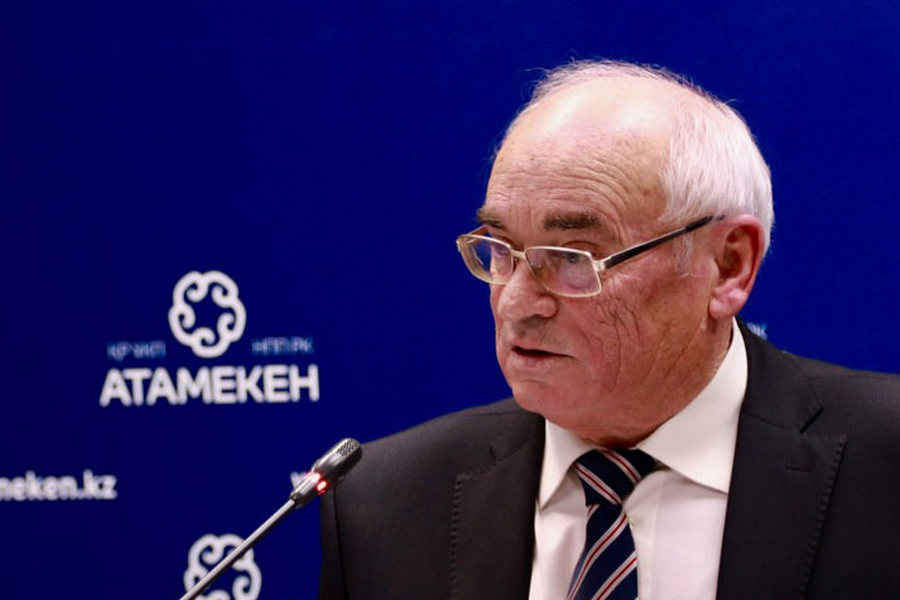Managing Director of the European Bank for Reconstruction and Development for Central Asia Andre KUUSVEK:
A REDUCTION IN GRAIN EXPORTS FROM KAZAKHSTAN AND THE RUSSIAN FEDERATION THREATENS GLOBAL FOOD SECURITY

The national markets of the Central Asian countries are too small and remote for attracting high quality investments and the creation of integrated markets and infrastructure could promote diversification of the economies of the region. In an interview with Interfax-Kazakhstan Andre KUUSVEK, managing director of the European Bank for Reconstruction and Development (EBRD) for Central Asia, talked about why trade restrictions on agricultural produce in Central Asia could threaten global food security.
- Mr. Kuusvek, in your opinion, what are the risks of the COVID-19 pandemic for food security in Central Asia? Will the countries of the region be able to meet each other's [food] needs?
- In the short run, food supply networks throughout the region have been temporarily disrupted by border closures and other protective measures applied by the governments in Central Asia, China, Russia and other neighbouring countries. Farmers are struggling to bring supplies, such as animal feed or chemicals, and deliver their produce because of lockdown measures; some workers are finding it difficult to travel to farms and factories they are employed with. Still, agriculture and the food industry have not been seriously damaged by the pandemic, and the renewed emphasis on food security (within the framework of the Eurasian Economic Union (EAEU) and in individual countries) will result in further incentives and initiatives for their development.
At the same time,it would be a pity to see the Central Asian countries going too far with restrictions on trade in agricultural produce. Prior to the crisis, we saw a strong tendency towards greater regional integration, which was at least partially related to the reopening of Uzbekistan’s economy. More trade implies greater specialization, competitive pressure on domestic producers, and greater efficiency. Uzbekistan’s agricultural production and processing is more diversified than elsewhere in Central Asia, and the country’s food exports have been rapidly growing in the last couple of years, reaching about 9% of total exports in 2019. Uzbekistan’s food exports have been putting downward pressure on prices in Kyrgyzstan and Tajikistan, to the benefit of domestic consumers.
Unfortunately, the crisis may have started a trend towards reduced trade, as countries try to build greater self-reliance. As a temporary measure, this is understandable. However, it is important to understand that such a strategy comes at a cost. The decisions by Russia and Kazakhstan to cut grain exports to non-EAEU countries, for example, are threatening global and Central Asian food security at a time of a crisis, causing critical food prices to go up. They are also costly for domestic grain producers, reducing their revenues and, ultimately, their interest in investing.
- Which countries of Central Asia are most prepared and have the required strength reserve to withstand the crisis in the face of the COVID-19 pandemic?
- With the possible exception of Turkmenistan and Uzbekistan, all the countries in Central Asia, where the EBRD is active, are expected to go into a recession. According to our latest economic forecasts, on average, the Central Asian economies, which have come under pressure from the collapse in commodity prices and remittances, will contract by 1.2% this year, before a rebound of 5.8% in 2021.
Oil and gas exporters, such as Kazakhstan, Turkmenistan and Uzbekistan, rely on significant fiscal buffers and international reserves to cushion the negative impact on the economy. Still, they are being strained by the dramatic decline in the demand for energy resources. Uzbekistan is in a slightly better position being more diversified and having gold as a key export commodity. The countries, such as the Kyrgyz Republic and Tajikistan are extremely dependent on remittances, have no fiscal space to implement significant stimulus measures, and are limited in their ability to borrow due to high levels of external debt and lack of debt servicing capacity.The role of the IMF, the international development banks and donors will be highly relevant once again.
- Should we expect a reduction in foreign investment in the region in the years to come? Which sectors will suffer the most?
- Investors’ interest in the region will recover towards the middle of 2021, when demand conditions more or less return to pre-crisis levels. Assuming oil and gas prices remain depressed, and the governments attempt to stimulate the development of non-extractive industries, we may see greater volumes of investment in agriculture, food processing, pharmaceuticals, and other types of manufacturing activities.
It is clear that the recovery process is expected to be relatively slower in the sectors such as air travel, tourism and hospitality. It will take a while for international companies to resume business travel, especially with the adoption of Zoom, Webex and other remote conferencing tools. Just to give you an example, the EBRD has banned all international travel and made significant investment in cloud technologies in order to enable distance working, business meetings and conferencing. The demand for offices, commercial real estate may also take a long time to pick up due to a general decline in business activity and accelerated adoption of remote working, shopping and studying. These very trends are likely to boost development the IT sector, online retail and delivery services, as well as digital services. Education is another area, where one could expect revolutionary changes thanks to accelerated technology adoption.
I would like to emphasise that the current crisis is very different from the global financial crisis of 2007-2009. Whilst the last major crisis originated from the banking and property sectors, this time, it is a major health issue that hits the real economy directly, affecting the manufacturing and services sectors first. The commercial banks, whilst better capitalised and liquid, have actually stopped lending, and are expected to be hit by worsening quality of their loan books. The banks in Central Asia will need to do a better job in financing the small and medium sized enterprises. The EBRD is willing to play a role in trying to attract some of the international banks to invest in Central Asia.
- Has the EBRD adjusted its investment plan for Kazakhstan and Central Asia for 2020?
- The EBRD Board of Directors decided in late April to expand our response and recovery programme addressing the coronavirus crisis effects, and vast majority of the Bank’s investments of up to €21 billion in the two years ahead is expected to be dedicated to this effort. The programme’s main element, the Resilience Framework, has been increased to €4 billion and will be immediately available to existing clients, including those in Central Asia.
The EBRD will also increase its financing under the Trade Facilitation Programme to support exporters and importers, stimulate international trade. For instance, we have earmarked €220 million trade finance lines to four banks in Uzbekistan. When needed, we will help companies restructure their outstanding obligations and channel more resources to support small and medium-sized enterprises, which play such an important role in job creation throughout the region.
We have also introduced the so-called Vital Infrastructure Support Programme to meet demands for financing working capital, stabilisation and public investment in water and power supply, municipal transport and infrastructure projects. We have already provided a number of loans to companies across the region ranging from agribusiness clients in Uzbekistan and Turkmenistan to water projects in the Kyrgyz Republic.
- Since 2016, Kazakhstan has been actively pursuing privatisation in the public sector, and in 2020-2021 major IPOs of state-owned national companies should have taken place. In your opinion, how will the COVID-19 pandemic affect the attractiveness of these assets for investors?
- The pandemic triggered a collapse in stock market indices across the world, and market volatility has risen to its highest level since the 1990’s. Many companies globally are going to delay IPOs this year. In Kazakhstan, KazMunayGas and Air Astana were supposed to launch IPOs in 2020, but given the state of oil markets and the airline sector, the management has indicated that these IPOs will be postponed.
However, meanwhile we have seen a further stake of Kazatomprom being privatised, a step that would incease the free float of the stock. Though the year 2021 may be a better year, air travel and demand for oil and gas are unlikely to recover to pre-COVID-19 levels, making the timing of IPOs very uncertain.
- The EBRD is the largest investor in renewable energy in Kazakhstan. How will the COVID-19 pandemic affect the renewable energy sector in the region and in Kazakhstan in particular?
- Indeed, over the past five years, the EBRD has financed 672 MW of renewable capacity in Kazakhstan. The country has for generations relied on coal-fired power,but, since we have started our cooperation in this field in 2008, it has seen significant investment in renewable energy, particularly solar energy. Importantly, we have worked with the government of Kazakhstan to create an appropriate legal framework, including a renewable energy law, a feed-in tariff system, and develop the National Concept for the Transition to Green Economy in 2013. The first large-scale renewable power project, a 50 MW solar plant, was commissioned in 2015.
Our current priority is to support Kazakhstan’s transition to competitive tendering of renewable projects.The current crisis is certainly not helping Kazakhstan’s green transition. On the one hand, lower oil and gas prices are reducing the financial incentives for investment in green alternatives. On the other hand, increased macroeconomic volatility translates into inflation and exchange rate risks that raise the cost of financing green investment. I believe the big issues such as climate change will continue to be relevant for much beyond the COVID-19 effects.
- Can the pandemic and the crisis caused by it exacerbate water problems in Central Asia?
- The pandemic demonstrated the critical importance of maintaining highest hygiene and sanitation standards but water supply challenges are among most serious long-standing challenges facing Central Asia. It is common knowledge that these challenges have been exacerbated by years of underinvestment and difficulties of transboundary cooperation in the past 30 years. One the one hand, there is an urgent need to improve municipal water supply and treatment facilities. On the other, there is no escape from upgrading and rationalising the existing irrigations systems. Being extremely important for food security, these systems still rely on extremely old and inefficient Soviet-era equipment and are in dire need of optimisation and investment.
The crisis did affect the ability of the Central Asian governments to invest in public infrastructure, including water supply systems. It increased the pressure on the already tight fiscal situation practically in all countries in the region, including relatively rich Kazakhstan and Uzbekistan. The governments of Tajikistan, Kyrgyz Republic and Mongolia, on the other hand, are quite limited in their ability to borrow to increase their budgetary and fiscal space. The EBRD has long recognised the importance of municipal water supply and wastewater treatment systems. In the Kyrgyz Republic alone, the EBRD supported 23 water and wastewater improvement projects with the total value of over €180 million. The EU and Switzerland provided over €110 million out of this amount as grants.
It is possible to put as another example Tajikistan’s glacial hydrology and its hydropower sector that are highly sensitive to the impacts of climate change. To address this challenge, since 2009, the EBRD has been working with the Tajik authorities to eliminate leakages, extend and upgrade existing water supply and wastewater treatment systems in Tajikistan’s cities.
- COVID-19 poses a risk that the world will face protectionism and the breakdown of supply chains. In such circumstances, it will be more difficult for exporters in Central Asia to enter new markets. At the same time, the leaders of the countries of the region, and especially Kazakhstan and Uzbekistan, favour the expansion of economic cooperation. Don't you think that the Central Asian countries can move on to develop mutually beneficial substitution of goods and services within the region?
- In our most recent macroeconomic publication, Regional Economic Prospects, the EBRD argues that as the world emerges from the crisis it is crucial to look towards a future of cooperation and greater economic resilience. The crisis has been a massive hit and coming out of it will be extremely challenging. This is not the time to engage in economic nationalism and protectionism, but a time to shape a better future through international commitment to free trade, climate change mitigation and economic cooperation.This certainly also applies to the Central Asian region.
The national markets, even in the larger Central Asian economies, are too small and often too remote to attract quality investment in non-extractive activities, standing in the way of economic diversification efforts. The creation of single market, or a sufficiently integrated market could unlock significant investment, while also facilitating greater specialization and improving productivity. Additionally, tremendous gains could be made from a regional approach to investment in infrastructure, including roads, pipelines, water supply and electricity transmission networks. Moving in that direction would require improving regional governance and building trust. This may take time, but every journey begins with a single first step.
- Thank you for the interview.
June, 2020
© 2025 Interfax-Kazakhstan news agency
Copying and use of these materials without reference to the source is prohibited
Archive





